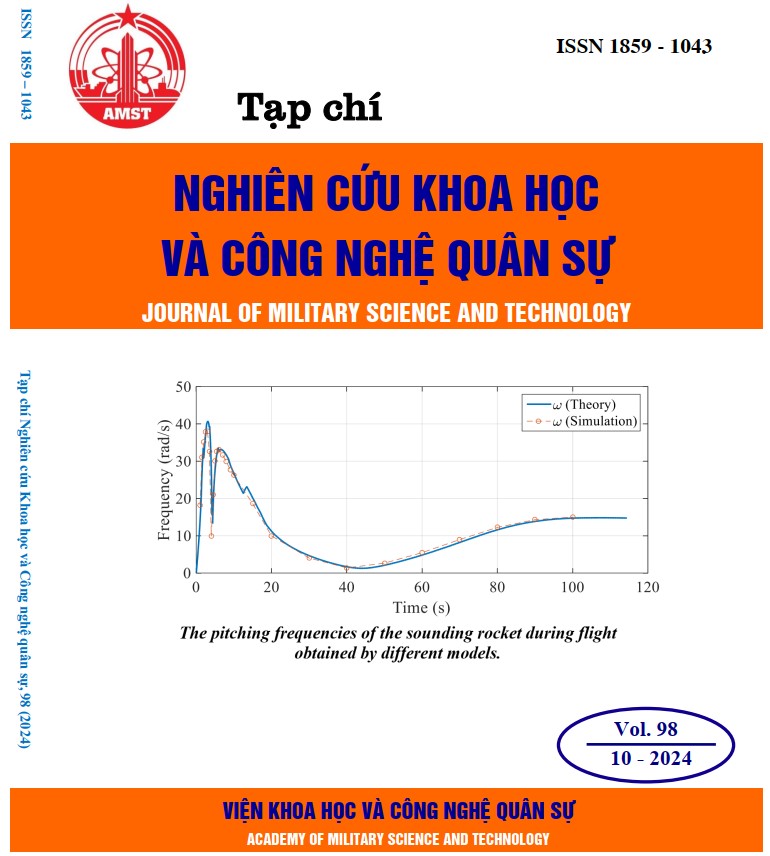Research and development of the dynamic multi-connection wireless sensor network model
297 viewsDOI:
https://doi.org/10.54939/1859-1043.j.mst.98.2024.69-77Keywords:
Wireless Sensor Networks; Dynamic Multi-Connection; Time Division Multiple Access; Capacity.Abstract
Wireless Sensor Networks (WSNs) consist of sensors connected wirelessly to collect information from the environment and transmit data to a central processing unit. WSNs are widely applied in healthcare, industry, and automation due to their ability to provide real-time information at a low cost. This research proposes a Dynamic Multi-Connection Wireless Sensor Network (DMC WSN) model integrated with Time Division Multiple Access (TDMA) to allocate transmission time efficiently, avoid signal interference, and enhance communication performance in production environments. Simulation results indicate that, when neither TDMA nor power control is employed, both the weakest sensor capacity and the average capacity are at their lowest levels. When the Max-Min algorithm is applied for power control, capacity is improved. Conversely, when TDMA is utilized, even without power control, both the weakest sensor capacity and the average capacity reach their highest levels. This demonstrates that TDMA significantly improves communication efficiency and ensures stable capacity for the DMC WSN model in production environments.
References
[1]. D. C. Nguyen et al., “6G Internet of Things: A Comprehensive Survey,” in IEEE Internet of Things Journal, vol. 9, no. 1, pp. 359-383, 1 Jan.1, (2022), doi: 10.1109/JIOT.2021.3103320. DOI: https://doi.org/10.1109/JIOT.2021.3103320
[2]. K. Shafique, B. A. Khawaja, F. Sabir, S. Qazi and M. Mustaqim, “Internet of Things (IoT) for Next-Generation Smart Systems: A Review of Current Challenges, Future Trends and Prospects for Emerging 5G-IoT Scenarios,” in IEEE Access, vol. 8, pp. 23022-23040, (2020), doi: 10.1109/ACCESS.2020.2970118. DOI: https://doi.org/10.1109/ACCESS.2020.2970118
[3]. I. Surenther, K.P. Sridhar, Michaelraj Kingston Roberts, “Maximizing energy efficiency in wireless sensor networks for data transmission: A Deep Learning-Based Grouping Model approach”, Alexandria Engineering Journal, Volume 83, Pages 53-65, ISSN 1110-0168, (2023). DOI: https://doi.org/10.1016/j.aej.2023.10.016
[4]. Hui Feng, Chen Xu, Bo Jin, Min Zhang, “A Deployment Optimization for Wireless Sensor Networks Based on Stacked Auto Encoder and Probabilistic Neural Network”, Digital Communications and Networks, ISSN 2352-8648, (2024). DOI: https://doi.org/10.1016/j.dcan.2024.06.003
[5]. H. Q. Ngo, A. Ashikhmin, H. Yang, E. G. Larsson and T. L. Marzetta, “Cell-Free Massive MIMO Versus Small Cells,” in IEEE Transactions on Wireless Communications, vol. 16, no. 3, pp. 1834-1850, (2017), doi: 10.1109/TWC.2017.2655515. DOI: https://doi.org/10.1109/TWC.2017.2655515
[6]. G. D. O'Mahony, J. T. Curran, P. J. Harris and C. C. Murphy, “Interference and Intrusion in Wireless Sensor Networks,” in IEEE Aerospace and Electronic Systems Magazine, vol. 35, no. 2, pp. 4-16, (2020). DOI: https://doi.org/10.1109/MAES.2020.2970262
[7]. B. T. Anh, D. Thanh Quan, D. D. Quoc and P. Thanh Hiep, “Optimizing Transmission Power for Uplink Data in Cell-Free Wireless Body Area Networks,” 2023 IEEE Statistical Signal Processing Workshop (SSP), Hanoi, Vietnam, pp. 275-279, (2023). DOI: https://doi.org/10.1109/SSP53291.2023.10208084
[8]. D. M. King, B. G. Nickerson and W. Song, “Evaluation of ultra-wideband radio for industrial wireless control,” 2017 IEEE 38th Sarnoff Symposium, Newark, NJ, USA, pp. 1-6, (2017). DOI: https://doi.org/10.1109/SARNOF.2017.8080385
[9]. Özlem Tugfe Demir, Emil Björnson and Luca Sanguinetti, “Foundations of User-Centric Cell-Free Massive MIMO”, Foundations and Trends in Signal Processing: Vol. 14, No. 3-4, pp 162-472, (2021). DOI: https://doi.org/10.1561/2000000109
[10]. M. B. Majed, T. A. Rahman, O. A. Aziz, M. N. Hindia, and E. Hanafi, “Channel characterization and path loss modeling in indoor environment at 4.5, 28, and 38 GHz for 5g cellular networks”, International Journal of Antennas and Propagation, vol. 2018, pp. 1–14, (2018), doi: 10.1155/2018/9142367. DOI: https://doi.org/10.1155/2018/9142367
[11]. Al-Khero, S Kh and Abbosh, Y M, “Path Loss and Channel Modeling at 3.5GHz for 5G Cellular System”, IOP Conference Series: Materials Science and Engineering, vol.1152, p.012006, (2021), doi: 10.1088/1757-899x/1152/1/012006. DOI: https://doi.org/10.1088/1757-899X/1152/1/012006
[12]. Ghayoula et al, “Capacity and Performance of MIMO systems for Wireless Communications”, Journal of Engineering Science and Technology, vol. 7, pp.108-111, (2014), doi: 10.25103/jestr.073.17. DOI: https://doi.org/10.25103/jestr.073.17







